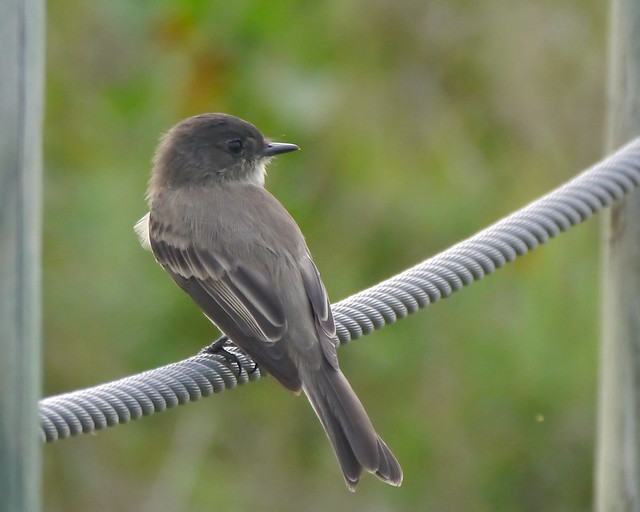After the Wilson's Warbler, fall migrants were few and far between. We heard a few Blue-gray Gnatcatchers and Dickcissels, and we briefly heard and saw a Baltimore Oriole. In the playing fields at the first creek crossing, 9 Least Sandpipers flew in from downstream and landed in a soccer field on the north side of the creek. We crossed the creek and walked up the north bank just enough to watch the sandpipers at eye-level as they foraged for insects in the mowed grass. Some Least Sandpipers are winter residents here on our creek, so these particular birds might be here all winter or they might be just passing through on their way further south.

Our most exciting observation of the morning was unexpectedly emotional as well. Before the Least Sandpipers flew in we were on the south side of the creek and spotted a Yellow-billed Cuckoo in the dense brush of the creek bed. Yellow-billed Cuckoos are declining in number because of habitat loss, and I see and hear fewer of them than I used to years ago. So I was very happy that we found this one. I got this poor photo showing its yellow bill and reddish-brown wing patches:

The cuckoo soon disappeared into the dense brush again, and we walked across to see the sandpipers. When we returned to the south side of the creek we found a juvenile Cooper's Hawk perched up some netting on the north side of the creek. As we watched, the hawk flew towards us down into the creek bed. Out popped the cuckoo. The hawk was chasing it!
Yellow-billed Cuckoos often stay hidden in dense tree canopies, and when you do finally see one, it has a hunched-over droopy posture. But when one flies it transforms into elegance. Its long pointed wings flap slowly and smoothly taking it where it wants to go in long undulations through the air.
So the cuckoo seemed unhurried even though it was fleeing for its life from the Cooper's Hawk. It flew up the creek bed to the high fence behind a baseball field, and at least twice it flew through the holes in the chain-link fencing which the hawk couldn't fit through, causing the hawk to go around the fence to continue the chase. Was this a trick the Yellow-billed Cuckoo already knew? The cuckoo disappeared into a dense ash tree on the creek bank and the hawk flew in after it. But soon the hawk emerged by itself and left the area. The cuckoo had escaped.
As I watched this brief encounter my eyes welled up a bit and my shoulders tensed. Were we about to witness the death of a bird of an already imperiled species on my neighborhood bird walk? The group shared my concern and someone even shouted at the hawk something like, "No, don't go after the cuckoo, find another bird!" We were relieved but stunned after the hawk left. I think there would have been tears in the group if that Yellow-billed Cuckoo hadn't escaped. Some of those tears might have been mine!
Cooper's Hawks specialize in hunting other birds, and they used to be common here in the winter but rare in the summer. In the past few years, more and more have been breeding in central Texas and they've become more common here during the summer. A pair has been nesting in the dense woods along the first half-mile of trail, and this bird might have been one of their offspring. In our neighborhood I would guess Cooper's Hawks eat mostly White-winged Doves. I hope this juvenile bird discovers a preference for that plentiful species.
On our way back we found a Great Crested Flycatcher in the woods, a summer resident that will soon be heading south. Eastern Phoebes, our only year-round resident flycatcher species, were plentiful along the trail. Here's one of them:

Here's our complete bird list.
And here are the same photos on Flickr.

No comments:
Post a Comment